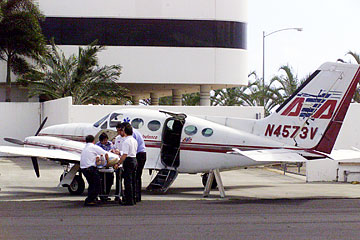
STAR-BULLETIN / FEBRUARY 2004
A patient is unloaded off of a Hawaii Air Ambulance plane.
|
|
Crash shows limited Medevac alternatives
Hawaii's only private air ambulance firm prepares to resume flights on Tuesday
All three of Hawaii Air Ambulance's remaining planes will likely be back in the air by Tuesday after being independently inspected to allay fears following last week's fatal crash on Maui, company officials say.
But it's unclear if the maintenance check, which has cleared one aircraft so far, will be enough for some nurses and paramedics, who have refused to fly with Hawaii Air Ambulance since Wednesday's accident.
ABOUT HAWAII AIR AMBULANCE
» Started operating 25 years ago.
» Is the state's only fixed-wing aeromedical provider.
» Has flown over 37,000 flights in Hawaii, with two fatal crashes.
» Employs 60 people, including pilots, nurses and part-time paramedics.
» Has three Cessna 414-A aircraft and is looking at a fourth to replace the one lost in the Maui crash Wednesday.
|
The situation has complicated the company's return to regular operations while also highlighting the state's dearth of air ambulance options, which will further shrink April 1 when the Army plans to stop using its 12 helicopters to fly critical patients from rural Oahu. The Army's Black Hawk helicopters are being taken out of the medical service to prepare for a deployment in Iraq that starts this summer.
"There are enough providers, but not enough contingencies," said Toby Clairmont, Healthcare Association of Hawaii emergency program manager. "There's one firm providing each line of service -- so when you lose one, you're immediately in a crisis."
Even before the Hawaii Air Ambulance crash that killed the pilot and two medical personnel, the state Department of Health was working on a plan to address the issue, Clairmont said. One of the department's considerations is whether there is room in the market for a second air ambulance service.
A bill moving through the Legislature would provide funds for air medical services to rural Oahu, but the earliest it could go into effect is July.
"Maybe the action planning needs to be escalated," Clairmont said yesterday. "We used to have the luxury of time. But more people are living on the neighbor islands and their expectations are growing.
"A more comprehensive, resilient system of air medical transportation needs to emerge for the state of Hawaii."
Hawaii Air Ambulance is the state's only private, fixed-wing aeromedical provider. While its planes have been grounded, the company has contracted with commercial aircraft to fly patients. The Coast Guard has also helped, flying 13 people on its two C-130s since Thursday, spokeswoman Jennifer Johnson said.
But what happens if Hawaii Air Ambulance is grounded again and the Coast Guard's C-130s are responding to a sea emergency, which the agency has made clear is its priority?
Or what if some nurses still won't fly with the company, even after the safety check is complete?
The questions, which Hawaii health leaders are considering, are especially pressing after the only nurses in the state who transport critically ill children from the neighbor islands to the Kapiolani Medical Center for Women and Children said this week they will not go back up in the company's planes -- at least for the time being.
They are currently flying children on the Coast Guard's C-130s and commercial airplanes.
Hawaii Air Ambulance President and Chief Executive Officer Andrew Kluger said he plans to meet with the nurses Tuesday to discuss their concerns.
Meanwhile, 10 of Hawaii Air Ambulance's 60 employees have also not flown since the accident and are unsure when they will return to the air.
And city Emergency Medical Services spokesman Bryan Cheplic confirmed yesterday that two paramedics who work part-time for Hawaii Air Ambulance will not go back up with the company.
The crash in Kahului on Wednesday night was Hawaii Air Ambulance's second in a little over two years. On Jan. 21, 2004, three people died when a Hawaii Air Ambulance plane went down on Mauna Kea. The cause of the crash was never determined.
Pat Oda, Kapiolani Medical Center spokeswoman, said nurses fly about 40 critically ill children from the neighbor islands each month. She could not say what the nurses would need from Hawaii Air Ambulance to get them back in the air with the company.
"It is true there is concern and there's a lot of grieving," Oda said, adding that the nurses knew all three of those killed in Wednesday's crash. "But we never did stop flying."
She did not want to comment on what would happen if the nurses did not want to go back with Hawaii Air Ambulance.
Kluger said yesterday that he doesn't "want anybody feeling uncomfortable flying on our aircraft," which is why he ordered an independent review of his planes. He declined to release the name of the examiner, but said he is respected and works with a large Hawaii airplane company.
Kluger also said the inspector has found nothing significantly wrong with the planes. There have been a few "general maintenance" issues, he said, but "nothing critical."
In his meeting with the Kapiolani nurses, Kluger will share the findings of the examiner in hopes of convincing them that his planes are safe.
"We're in a dangerous business and we're very close in our community," he said, adding that the employees at his company who have not gotten back in the air "wanted some time to grieve."

